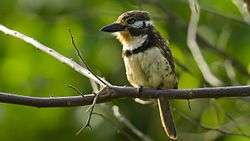Russet-throated puffbird
| Russet-throated puffbird | |
|---|---|
 | |
| Scientific classification | |
| Kingdom: | Animalia |
| Phylum: | Chordata |
| Class: | Aves |
| Order: | Piciformes |
| Family: | Bucconidae |
| Genus: | Hypnelus |
| Species: | H. ruficollis |
| Binomial name | |
| Hypnelus ruficollis (Wagler, 1829) | |
The russet-throated puffbird (Hypnelus ruficollis) is a near-passerine bird which breeds in tropical South America in northeastern Colombia and northwestern Venezuela. It is commonly named in Colombia as Bobito, Utta, Tol and Coludo.
The puffbirds are an insectivorous bird family related to the jacamars, but lacking the iridescent colours of that group. The russet-throated puffbird is fairly common in dry scrub and dry forest. It excavates a burrow in an arboreal termite colony and lays three white eggs.
The russet-throated puffbird is typically 22 cm (8.7 in) long and weighs 50 g (1.8 oz). It is a dumpy bird with a large head, a long tail and a thick black hooked-tipped bill. The face is mainly white with a large yellow eye. The upperparts are brown with whitish spotting and white wing tips.
The underparts vary considerably. The two western subspecies have an off-white throat, buff underparts, and two dark brown chest bands. Some authorities split this genus into two species, the other being the two-banded puffbird, H. bicinctus.[2] The three subspecies found in Colombia and in Venezuela east of the Andes have a single breast band, a deep rufous throat and whitish or buff underparts.
This insectivore hunts from a perch, sitting and watching, then flying down to catch insects, lizards and other small prey.
The russet-throated puffbird's call is a long series of woduk notes, often given synchronously by a pair of birds.
References
- ↑ BirdLife International (2012). "Hypnelus ruficollis". IUCN Red List of Threatened Species. Version 2013.2. International Union for Conservation of Nature. Retrieved 26 November 2013.
- ↑ "Hypnelus bicinctus". Avibase.
- Birds of Venezuela by Hilty, ISBN 0-7136-6418-5
